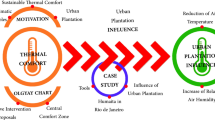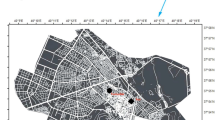Abstract
The climatic conditions of seven beach holiday resorts in South Africa (Alexander Bay, Cape Town, George, Port Elizabeth, East London, Durban and Richard's Bay) have been examined with regard to the thermal perception of beach holiday makers. The evaluation of the thermal conditions is based on the human energy balance calculations which have been adapted to the requirements of beach goers. A model has been developed to calculate the missing radiation input data and parameters such as ‘beach day’ and ‘beach hour’ are introduced and defined. The average monthly number of beach days is calculated for every location showing the highest amounts in Durban and Richard's Bay and the highest annual variations in Cape Town. The Beach Comfort Index Map of South Africa shows the maximum, minimum and average number of beach days per month and the probability of beach days and thus providing understandable and interpretable information on the thermal conditions of the sites from the point of view of beach holiday makers.
Similar content being viewed by others
References
Adams, T. and Covino, B.G.: ‘Racial variations to a standardized cold stress.’ J. Appl. Physiol., 12: 9–12 (1958).
Becker, S.: Wärmebelastung in Israel. Quantifizierung, Regionalisierung und kurortklimatologische Analyse der thermischen Belastung des Menschen. Dissertation, Justus-Liebig Universität Gießen, 1996.
de Freitas, C.R.: ‘Assessment of human bioclimate based on thermal response’. International Journal of Biometeorology 29: 97–119 (1985).
Fanger, P.O.: Thermal Comfort: Analysis and applications in environmental engineering. McGraw-Hill, New York, 1972.
Givoni, B.: Man, climate and architecture. Applied science publisher Ltd. London, 1976.
Ganong, W.F.: Medizinische Physiologie, Springer Verlag, Berlin, 1971.
Hardy, J.D., Muschenheim, C.: ‘The radiation of heat from the human body’. Journ. Clin. Invest., 13 (1934).
Höppe, P.: Die Energiebilanz des Menschen. Wissenschaftliche Mitteilungen des Meteorologischen Institutes der Universität München, 49, 1984.
Hellmann, G.: ‘Über die Bewegung der Luft in den untersten Schichten der Atmosphärc’. (2. Mitteilung.) Meteorologische Zeitschrift 34.273–285 (1917).
Jendritzky, G., Menz G., Schirmer H., Schmidt-Kessen, W.: ‘Methodik zur räumlichen Bewertung der thermischen Komponente im Bioklima des Menschen’. Beiträge der Akademie für Raumforschung und Landesplanung, Bd. 114, Hannover, 1990.
Kasten, F.: ‘Strahlungsaustausch zwischen Oberflächen und Atmosphäre’, VDI Berichte, Nr. 721, 1989.
King, E.: ‘Ein empirisches Schwülemaß’. Medizin. Meteorolog. Hefte Nr.10, 1951.
Kleiber, J.: Der Energiehaushalt von Mensch und Haustier. Verlag Paul Parey, Hamburg — Berlin, 1967.
Leistner, W.: ‘Die hygrische und klimatische Bedeutung des Dampfdrucks in Innenräumen und die Behaglichkeits-und Schwülegrenze’. Medizin. Meteorolog. Hefte Nr.6, 1951.
Mayer, H.: ‘Stadtklima und seine humanbiometeorologische Bewertung’. In: Mayer, H. (Hrsg.). 2. Treffen Arbeitskreis Human-biometeorologic, Wissenschaftliche Mitteilungen des Meteorologischen Institutes Nr. 53, München, 1986.
Mitchell, D.: ‘Measurement of the thermal emissivity of human skin in vivo’. In: Hardy, J.D. (Hrsg.) Physiological and behavioral temperature regulation. Charles T. Thomas, Illinois, 1970.
Nevins, R.G., Rohles, F.H., Springer, W., Feyerherm, A.M.: ‘A temperature-humidity chart for thermal comfort of seated persons’. ASHRAE trans. 72, part 1: 283–291 (1966).
Paltridge, G.W., Platt, C.M.R.: Radiative Processes in Meteorology and Climatology, Development in Atmospheric Science 5, Elsevier Scientific Publishing Company, Amsterdam-Oxford-New York, 1976.
Rohles, F.H.: ‘Thermal sensations of sedentary man in moderate temperature’. Inst. f. Environmental Research, Special report, Kansas State University, 1970.
Scharlau, K.: ‘Zur Einführung eines Schwülemaßstabes und Abgrenzung von Schwülezonen durch Isohygrethermen’. Erdkunde, Band 4, 188–201 (1950).
Seidl, H.: Möglichkeiten und Probleme bei der humanbiometeorologischen Bewertung von Urlaubsklimaten am Beispiel der Mittelmeerländer. Diplomarbeit am Lehrstuhl für Geographie der Ludwig-Maximilian Universität München, 1990.
Schulze, B.R.: ‘South Africa’. In: Climates of Africa, Ed. Griffiths, J.E., World Survey of Climatology, Vol. 10, Elsevier, Amsterdam, 501–586 (1972).
Schulze, B.R.: Climate of South Africa. Part 8, General Survey, WB 28, South African Weather Bureau, 5th Edition, 1984.
Sohar, E.: ‘Determination and presentation of heat load in physiologically meaningful terms’. Suppl. to International Journal of Biometeorology, Vol. 24, New York, 1980.
Terjung, W.H.: ‘The geographical application of some selected Physio-Climatic Indices to Africa.’ International Journal of Biometeorology, Vol. 11, New York, 1967.
Terjung, W.H.: ‘World Patterns of the Distribution of the Monthly Comfort Index’. International Journal of Biometeorology, Vol. 12, New York, 1968.
Tyson, P.D.: Climate Change and Variability in Southern Africa, Oxford University Press, Cape Town, 1986.
Underwood, C.R., Ward, E.J.: ‘The solar radiation area of man’. Ergonomics, Vol.9,No.2: 155–168 (1966).
Weihe, W.H.: ‘Die Wetterfühligkeit als Diskomfort’. Ann. d. Meteor. 22, 35–37 (1985).
Wyndham, C.H.: ‘Heat reactions of different ethnic groups.’ In: Environmental Physiology and Psychology in Arid Conditions. Arid Zone Research (UNESCO), 24: 143–156 (1964).
Wyndham, C.H.: ‘The adaptation of some of the different ethnic groups in southern Africa to heat, cold and exercise.’ S. African. J. Sci, 61, 11–29 (1965).
Author information
Authors and Affiliations
Rights and permissions
About this article
Cite this article
Becker, S. Beach Comfort Index – a new approach to evaluate the thermal conditions of beach holiday resorts using a South African example. GeoJournal 44, 297–307 (1998). https://doi.org/10.1023/A:1006871805262
Issue Date:
DOI: https://doi.org/10.1023/A:1006871805262




